Buddha Belly Bamboo (Bambusa Ventricosa) Profile
Written by Maggie
Oct 19 2021

Buddha Belly Bamboo (Bambusa ventricosa), is a tufted bamboo plant of Gramineae. Buddha Belly Bamboo is famous for its fast growth rate and impressive size. Buddha Belly Bamboo young culms are dark green, slightly pinkish white, olive yellow when old.
Buddha Belly Bamboo Picture
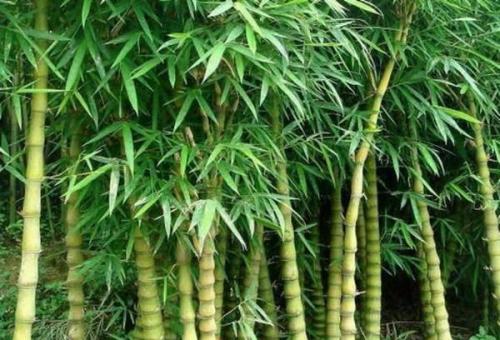
Varieties of Buddha Belly Bamboo
Dwarf Buddha Belly Bamboo
Yellow Buddha Belly Bamboo
Yello Buddha Belly Bamboo also called bambusa ventricosa Kimmei is another type of Buddha Belly Bamboo, which has culms that emerge green, but soon turn golden-yellow with green stripes. This is a very beautiful bamboo plant, Also referred to as Striped or Painted Bamboo, this cultivar is a popular choice for indoor and outdoor potted plants. In addition to this, it is also a top collector's bamboo that makes an excellent ornamental centerpiece, both indoors and out.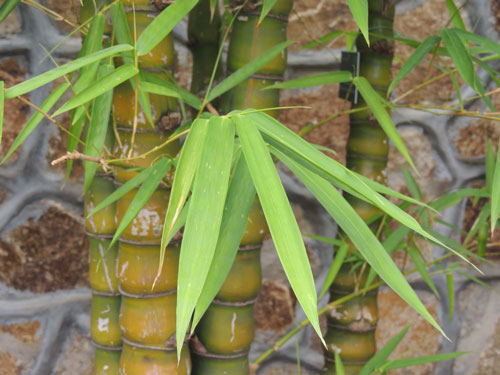
Buddha Belly Bamboo Characteristics
The first and second segments of the base also have short air roots;
Buddha Belly Bamboo is often used as a pot plant with artificial truncation to form deformed plants for ornamental use. When planted on the ground, it forms tall bamboo bushes, and occasionally a few deformed rods grow out of the normal rods.
Upon examination of the main model specimen of Buddha Belly Bamboo. Ventricosa CV. Nana, Wentai-Phi 85501 (Holoty P., ZJFI), it was confirmed that it is exactly the same as Buddha Belly Bamboo. Ventricosa McClure, and that the characteristics emphasized in its description are the same as those described by F. A. McClure in the original description, so it should be incorporated.
Gan-2: the normal pole is 8-10 meters high and 3-5 centimeters in diameter. The tip of the tail is slightly bent, and the lower part is slightly zigzag. Internodes of Buddha Belly Bamboo are cylindrical, 30-35 cm long, without ash powder when young, smooth glabrous, lower part slightly swollen; Each segment of the lower part of the culm is surrounded by a ring of gray silky hairs above and below the sheath ring, and there are short aerial roots on the first and second segments of the base. Branches of Buddha Belly Bamboo are usually start from the third and fourth nodes of the base of the rod, each node has 1-3 branches, the branchlets on the branches sometimes short to soft thorns, the middle and upper nodes of the rod are clustered with up to many branches, of which 3 are thicker and longer.
The malformed rod of Buddha Belly Bamboo is usually 25 -- 50 cm high, 1 -- 2 cm in diameter, short at the internodes and swollen at the base, flask shaped, and 2 -- 3 cm long; Each segment of the lower part of the culm is surrounded by a grey-white sericeous band above and below each sheath ring; Branches of Buddha Belly Bamboo are slightly tall, often single, without spines, their internodes slightly shortened and visibly swollen. Culm sheath caducous, abaxially completely glabrous, longitudinal ribs conspicuously prominent when dry, apex nearly symmetrical broadly arched or sub truncate; Culm sheath auricles unequal, margin with curved tasculature, larger auricles narrowly ovate to ovate-lanceolate, 5-6 mm wide, lesser auricles ovate, 3-5 mm wide; Culm sheath tongue of Buddha Belly Bamboo is 0.5-1 mm tall, margin covered with very short fine fimbriate hairs; Culm sheaths are erect or abductive, easily detached, ovate to ovate-lanceolate, base slightly cordate-narrowed, width slightly narrower than apex of culm sheaths. Leaf sheaths are glabrous; Auricles if Buddha Belly Bamboo are ovate or falcate, margin with several curving tassel hairs; Ligule is very short, subtruncata, margin by very short cilia; Leaf blade of Buddha Belly Bamboo is linear-lanceolate to lanceolate, 9 -- 18 cm long, 1 -- 2 cm wide, upper surface glabrous, lower surface densely pubescent, apex acuminate with subulate point, base suborbicular or broadly cuneate.
Pseudo Skelets of Buddha Belly Bamboo are solitary or in clusters of several on each node of flowering branches, linear-lanceolate, slightly oblate, 3-4 cm long; First emergent leaves broadly ovate, 2.5-3 mm long, 2-rigid, ridged with short cilia, apex obtuse; Bracts 1 or 2, narrowly ovate, ca. 4 -- 5 mm, 13-15 veined, apex acute; Spikelets contain 6-8 bisexual florets, of which 1 or 2 basal florets and 2 or 3 terminal florets are usually infertile; Cob internodes are oblate, 2-3 mm long, tip enlarged cup-shaped, margin short ciliated, glume often without or only 1 piece, ovate-elliptic, 6.5-8 mm long, with 15-17 veins, apex acute; Lemma of Buddha Belly Bamboo is glabrous, ovate-elliptic, ca. 9-11 mm, with 19-21 veins, small transverse veins between veins, apex acute; Lemma is subequal to lemma, 2-rigid, short-ciliated near the apex, 4-veined on both sides of the interridges and outer ridges, apex acuminate, apex with a small tuft of white pilose; Buddha Belly Bamboo has 3 scales, ca. 2 mm long, margin with long ciliate upper part, anterior two slightly asymmetrical shape, posterior one broadly elliptic; Filaments are slender, anthers yellow, 6 mm long, apex obtuse; Ovary is stipitate, broadly ovate, 1-1.2 mm long, apically thickened and hairy, styles very short, hairy, stigmata 3-minute, ca. 6 mm long, feathery.
Buddha Belly Bamboo Distribution
Buddha Belly Bamboo plant is produced in Guangdong, and has been introduced and cultivated in South China, Malaysia and America in Asia.
Buddha Belly Bamboo Ecological Habits
Buddha Belly Bamboo likes warm, wet, not cold. It is suitable to grow in fertile, loose, moist, well-drained sandy loam. It is distributed at home and abroad. Buddha Belly Bamboo is often used as pot, with artificial truncated cultivation, forming deformed plants for ornamental; When planted on the ground, it forms tall bamboo bushes, and occasionally a few deformed rods grow out of the normal rods.
Buddha Belly Bamboo is a light tolerant and moisture tolerant plant. It likes wet, warm and humid climate, and has low cold resistance. Buddha Belly Bamboo can withstand light frost and extreme low temperature of 0℃. However, plants suffer from cold damage in long-term low temperatures of 4~6℃. In tropical areas south of the Tropic of Cancer, it can be safely overwintered in the open, and can be cultivated in the leeward to the sun of northern South China. Central China to the vast area of North China, all appropriate potted, buy greenhouse or indoor winter. Buddha Belly Bamboo is pleasant to light, also slightly tolerant shade soil. Buddha Belly Bamboo likes fertile moist acidic soil, quite resistant to water wet, not resistant to drought, plant or plants, are appropriate for the soil moist often, calcium magnesium phosphate or rotten livestock manure as basal, growth stage nitrogen water once a month or every other month, to keep the stem yellow-bright infusion, leaf green, but should not be nitrogen fertilizer applying too much, lest appear every quarter growth is too long, not form a Buddha belly shape, reduce the ornamental value.
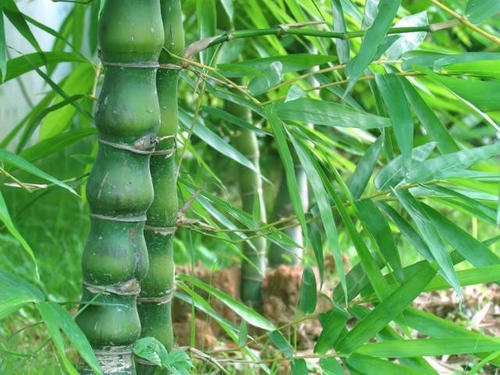
Buddha Belly Bamboo Care
| Scientific Name | Bambusa Ventricosa |
| Other Names | Buddha Belly Bamboo, Buddha Bamboo, Dwarf Buddha Belly Bamboo |
| Plant Type | Bamboos |
| Plant Family | Bamboos |
| Exposure | Full Sun, Partial Sun |
| Season of Interest | Spring (Early,Mid,Late), Summer (Early,Mid,Late), Fall, Winter |
| Height | 40'- 50' (12m- 15m) |
| Spread | 30' - 40' (9m- 12m) |
| Water Needs | Average |
| Maintenance | Low, Average |
| Soil Type | Loam |
| Soil pH | Acid, Alkaline, Neutral |
| Soil Drainage | Moist but Well-Drained |
| Characteristics | Showy, Evergreen |
| Tolerance | Deer |
Buddha Belly Bamboo Light Reqiurements
Buddha Belly Bamboo Soil
Buddha Belly Bamboo Watering
In summer: Lots of watering
In Winter: Less Watering
If you have a large garden, compare and discover plants that need lots of water and you will be able to decide the irrigation method to install in your garden. For over-watering plants drip irrigation is implemented. Such methods will help to water your plants in precise quantities ensuring their perfect care.
Buddha Belly Bamboo Temperature & Humidity
Buddha Belly Bamboo Fertilizer
Buddha Belly Bamboo Pruning
Always use sharp, clean tools when pruning Buddha Belly Bamboo. There are many tools available depending on the job. Hand shears, pruners, and loppers are ideal for most shrubs. Pole pruners and tree saws are better for large, mature shrubs or trees. If a tree is so large that it can't be safely pruned with a pole pruner, it is best to call in a professional tree service.
Buddha Belly Bamboo Pests & Diseases
Prevention and control methods: rust with 50% wilting rust ling wettable powder 2000 times the liquid spray, nevus with 50% methyl tobujin wettable powder 500 times the liquid spray.
The most common pests of Buddha Belly Bamboo are scale insects and bamboo locusts
Scale insect control methods:
1. In the nymphal period, spray insecticide, and add proper amounts of kerosene, the insecticide body has the effect of sealing and suffocating.
2. Spray washing powder aqueous solution on Buddha Belly Bamboo. The method is to dissolve the washing powder in water according to the proportion of 1:100, stir evenly and place it for 6 hours, then add 40% oxidized dimethoate emulsion or dichlorvos emulsion, and spray it in time after dilution of 1:1500 times, even spraying 2-3 times. Spray 2-3 days after the application of water will be the whole plant leached clean.
You can also use 60 degrees of white wine, 1:2 pairs of water, in the spring when the scale insects start to move. Pour 4 tablets 1 time, then every 15 days 1 time, continuously 8-9 times can achieve the control effect. See Cycas pest control section for other methods.
The Buddha Belly Bamboo locust control method: use 90% trichlorfon active drug 1500 times liquid spray kill.
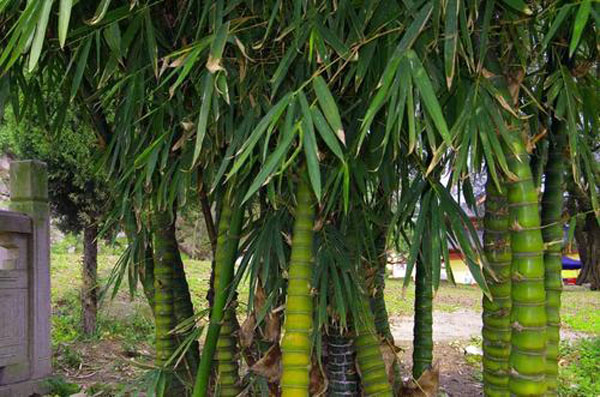
Buddha Belly Bamboo Propagation
Buddha Belly Bamboo Seeds Propagation
- Mix a 1:1 ratio of perlite to peat moss. Spread evenly in a planting tray. Lightly water until it is moistened, using a hand-held mister.
- Place the Buddha Belly Bamboo seeds in a plastic container. Hold the container under running water, and rinse the seeds thoroughly. Alternatively hold the seeds in your hand, allowing the water to run over the seeds and through your fingers. Rinse the seeds thoroughly to remove any dirt or debris.
- Obtain a 10 percent saline solution from a pharmacy, or purchase a 100 percent master saline solution and dilute at 1 part solution to 9 parts water. Place the seeds in a plastic container and spread out as much as possible. Add just enough saline solution to cover the seeds. Leave the seeds to soak for 15 minutes. Remove the seeds from the salt solution, and rinse under running water.
- Place the bamboo seeds in another plastic container, and cover with fresh water. Leave the seeds to soak for 15 minutes. Transfer the seeds from the fresh water soak directly to the planting tray.
- Plant the Buddha Belly Bamboo in the planting tray by scattering or sewing in neat rows. Cover the seeds lightly with the perlite and peat moss mixture. Place the cover on the planting tray, and set the tray in a warm location out of direct sunlight. A temperature of between 65 and 75 degrees Fahrenheit is optimal for germination. Check the moisture content of the tray a couple of times per week, and mist with water if necessary to maintain moisture.
- Monitor the growing tray for three to four weeks until Buddha Belly Bamboo seeds begin to germinate and break the surface of the soil. Leave the cover in place until the seedlings are tall enough to touch it, and then remove the cover. At one month after germination, add all-purpose liquid fertilizer to the water in the mister, following the manufacturer's directions for ratio and application. When seedlings reach 4 to 6 inches in height, or one month following germination, seedlings may be transplanted into 4-inch-diameter pots.
Buddha Belly Bamboo Cutting Propagation
- Select a culm and trim the primary branches of Buddha Belly Bamboo. Branches should preferably be cut at a young to intermediate maturity (1-2 years) to guarantee a high survival rate. Discard the top portion leaving 2-3 nodes and the basal swell. These bamboo cuttings are usually around 30cm long.
- Alternatively (to give faster results) dip the bamboo cuttings in a growth regulator mixture or rooting hormone for 24 hours, and seal the top cut end with wax to prevent desiccation.
- Plant the Buddha Belly Bamboo cuttings vertically (preferably in a slight angle), either in poly bags or raised beds in such a way that the rhizomatous swelling and one node remain below the soil surface and at least one or two nodes above the surface.
- Keep the Buddha Belly Bamboo under partial shade (agro shade nets provide 75% shade) and water the soil daily.
Dig up part of the plant more in autumn, and then divide planting. The north can only be planted in hothouse pots or in planters, such as in rows of various bamboos, with brick partitions in the planters to prevent the college of underground stems from mixing the species. Buddha Belly Bamboo should be replaced and planted every February. Choose slightly acidic soil, with loose leaf rot soil and fertile mineral soil mixed use had better. When replacing the soil, the old and the old must be uprooted in part so that new roots can easily grow. To choose shallow basin planting, control the root speed, so that the Buddha Belly plant shoots corresponding upward slow growth, transverse thickening. Summer rain even, potted bamboo water adaptation, unearthed most of the bamboo shoots section short, belly big. The dry weather at the end of autumn, potted bamboo water shortage, bamboo shoots only section long, flat abdomen. The overwintering temperature should not be lower than 5℃, and the basin soil should be kept relatively moist, and the leaves should be sprayed with clear water. Growth period, every half a month application of decomposed liquid fertilizer and phosphorus, potassium fertilizer, promotes bamboo shoots healthy and the formation of Buddha belly.
The new and old Buddha Belly Bamboo plant grow in clusters. In spring every year, when the temperature rises, before the new shoots germinate, the tender stems of 1 to 2 years old in the large clumps are cut down with roots from the base and soaked in water for 1 day and 2 days, so that the Buddha Belly Bamboo stems absorb enough water and most of the leaves are cut off. After planting, the Buddha Belly Bamboo shoots can survive. Cuttage in spring in the middle and late March, with 1~2 years of young bamboo culm in the strong main side branches or secondary branches as cuttings, each panicle reserved 3 node buds, cut off the leaves or upper leaves, with a section inserted into the wet sand bed. Often spray moisturizing, about 1 month can be hair root, 2 months or so can be moved into the nursery cultivation, the next year for the basin or 3~4 years of birth for the garden for open planting.1 seedling, can produce more seedlings, in each seedling leaving a little root stump, the next year can germinate into a new cluster, but also plant out of the nursery.
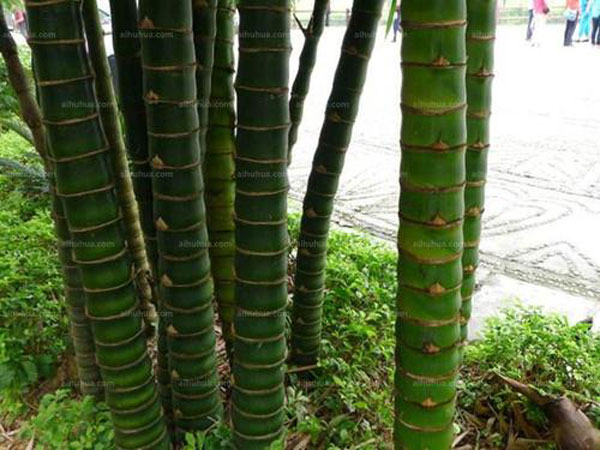
Buddha Belly Bamboo FAQ
Why is it called Buddha Belly Bamboo?
Can Buddha Belly Bamboo grow in a pot?
If you prefer potted plants, and you have time to give them extra care and attention, Buddha Belly also makes for an ideal bonsai specimen.
What to do if Buddha Belly Bamboo grows without bulbous culms?
In some cases, you might find that your Buddha Belly Bamboo are growing like ordinary bamboo, without the characteristic bulging or zig-zagging. But don't worry. Master bamboo gardeners have developed some tricks to help encourage this desirable trait by inducing stress.
One way to promote bulging culms is to prune the tops of the poles at least once a year. Without their tops, the bamboo will also tend to do more zig-zagging.
Stressing the Buddha Belly Bamboo plants with water deprivation is also a very effective method. Of course, you have to be careful not to over-stress and kill the plant. Generally, the leaves will start to curl when a bamboo is in need of water.
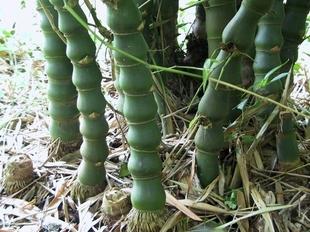
Buddha Belly Bamboo Garden Use
Buddha Belly Bamboo plant is bushy, short and deformed, shaped like Buddha belly, beautiful posture, green for four seasons. Potted several strains that year formed Fu Shucheng into the jungle type, composed with rocks, the ornamental effect is quite good.Indoor potted plants. View the leaf class, stalk shape is peculiar, simple and elegant, in the garden itself a scene.
Buddha Belly Bamboo is suitable for garden, park, waterfront and other places to plant, and rockery, rock and other configuration, more elegant.
Due to the big difference in temperature in different places, there are different kinds of bamboo suitable for cultivation. Buddha Belly Bamboo is one of the best ornamental bamboo with high ornamental value. It is not only suitable for open planting, but also suitable for pot planting for display. Also belong to the cultivation of more golden jasper, straw yellow, hanging green stripes; Buddha Belly Bamboo, bigger, short node, significant internode enlargement.
Potted bonsai
Buddha Belly Bamboo plant is a low and elegant plant with large internodes, shaped like Buddha's belly, strange shape, evergreen branches and leaves. It is an excellent material for potting and making bonsai, and also an ideal material for setting up a garden in the south.
Latest Updated
- Benefits of Bugleweed - 7 Science-backed Health Benefits
- Bugleweed Dangers & Side Effects - Is It Poisonous?
- How to Plant Evergreen Trees - What You Should Know
- When to Plant Evergreens - Grow Guide for Evergreen Trees
- 12 Wonderful Evergreen Shrubs for Your Garden
- 12 Popular Evergreen Plants with Pictures for Beginners
- When And How To Prune A Lilac Bush Like a Pro
- How to Grow & Care for Lilac Vine (Hardenbergia Violacea)
- Japanese Lilac Tree (Syringa Reticulata) Care & Propagation Guide
- Shumard Oak Pros and Cons - What to Know
Popular Articles
- Winter maintenance of Antirrhinum Majus
- How to Grow Terminalia Mantaly Tree
- How to Grow and Care for Crossostephium Chinense
- How to grow Antirrhinum Majus in spring
- Peristeria Elata (Dove Orchid) Profile: Info & Care Guide
- Underwatered Snake Plant (Sansevieria Trifasciata) - Signs And How To Fix
- How to Care for Brazilian Jasmine Plant (Mandevilla Sanderi)
- How to Grow & Care for Graptopetalum Purple Delight in Summer
- Rosa Chinensis (China Rose): Plant Growing & Care Tips
- How to Care for Baby Sun Rose (Aptenia Cordifolia)